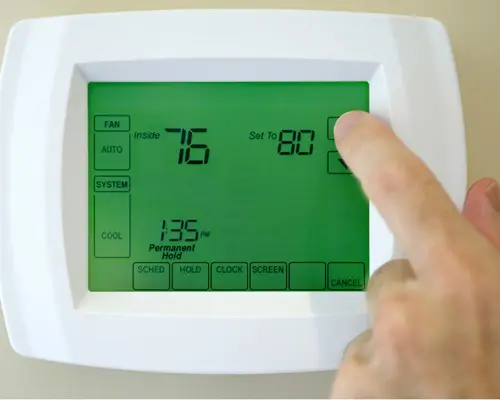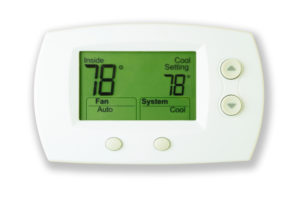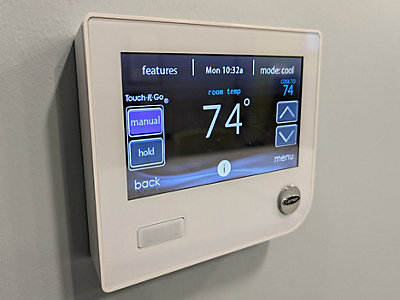Check Best Thermostat Pricing in Amazon
** As an Amazon Associate, I earn from qualifying purchases.
The “Fan Auto” setting on a thermostat means the fan operates automatically. It runs only during heating or cooling cycles.
This helps maintain comfort and save energy. Understanding thermostat settings can be confusing. The “Fan Auto” mode is one of the most important options. By setting your fan to auto, it only runs when necessary. This can lead to better energy efficiency and lower utility bills.
Knowing how to use this setting can improve your home’s comfort and save you money. Let’s explore how the “Fan Auto” setting works and why it’s beneficial.

Credit: sunset-air.com
- Introduction To Thermostat Fan Settings
- Understanding Fan Auto Mode
- Benefits Of Using Fan Auto Mode
- Drawbacks Of Fan Auto Mode
- Comparing Fan Auto And Fan On Modes
- Optimizing Home Comfort With Fan Auto
- Troubleshooting Common Fan Auto Issues
- Conclusion And Final Thoughts
- Frequently Asked Questions
- Conclusion
Introduction To Thermostat Fan Settings
When it comes to managing the comfort of your home, understanding your thermostat fan settings is essential. These settings can influence your energy bills, air quality, and overall home environment. If you’ve ever felt confused by the “Fan Auto” option on your thermostat, you’re not alone. Let’s break down what these settings mean and how they impact your home.
Importance Of Fan Settings
Fan settings on your thermostat play a crucial role in your home’s climate control. They determine how often the fan runs, which can affect the temperature consistency and air circulation.
Imagine coming home after a long day, expecting a cool environment, only to find your house stuffy and warm. Proper fan settings can prevent this scenario. They ensure your home stays comfortable by circulating air even when the heating or cooling isn’t active.
Common Fan Modes
Most thermostats have two primary fan settings: “On” and “Auto.” Each has its own benefits and drawbacks, depending on your needs.
- Fan On: This mode keeps the fan running continuously. It can help with air circulation and filtration. However, it can also increase your energy bills since the fan never stops.
- Fan Auto: In this mode, the fan only runs when the heating or cooling system is active. It’s more energy-efficient but might result in less air circulation between cycles.
Choosing the right setting involves balancing comfort with energy efficiency. If you have a multi-story home, you might find that “Fan On” helps maintain a more consistent temperature throughout. On the other hand, “Fan Auto” is often sufficient for smaller spaces.
Which fan setting do you prefer? Have you noticed a difference in your comfort or energy bills? Share your thoughts and experiences in the comments below!

Credit: www.ars.com
Understanding Fan Auto Mode
Homeowners often struggle to understand the “Fan Auto” setting on their thermostat. It’s an essential feature for maintaining comfort and energy efficiency. This mode can save money and improve air quality. Let’s dive into what Fan Auto means and how it works.
Definition Of Fan Auto
Fan Auto is a setting on your thermostat. It controls the fan operation based on the heating or cooling cycles. When set to Auto, the fan runs only during active heating or cooling. This mode ensures the fan is not running constantly.
How Fan Auto Works
In Fan Auto mode, the thermostat tells the fan to run only when necessary. When the temperature reaches the set point, the system starts heating or cooling. The fan then circulates the conditioned air throughout the home.
Once the desired temperature is achieved, the system shuts off. The fan also stops running. This cycling helps maintain a consistent temperature. It also conserves energy by not running the fan continuously.
Fan Auto is ideal for those who want to save on energy bills. It reduces wear and tear on the fan motor. This extends the life of your HVAC system. It also prevents unnecessary noise from a constantly running fan.
Benefits Of Using Fan Auto Mode
Using the Fan Auto mode on your thermostat offers several benefits. This setting ensures the fan only runs when heating or cooling is needed. It helps save energy, improves comfort, and extends the life of your HVAC system.
Energy Efficiency
Fan Auto mode helps reduce energy consumption. The fan operates only during heating or cooling cycles. This minimizes unnecessary energy use. Lower energy use means lower utility bills. It also contributes to a greener environment.
Extended Equipment Life
Fan Auto mode reduces wear and tear on your HVAC system. The fan runs less often, reducing strain on the components. Less strain means fewer repairs and longer system life. This ensures your HVAC system remains reliable for years.

Credit: www.climatecare.com
Drawbacks Of Fan Auto Mode
Fan Auto mode on a thermostat has its benefits. But there are also drawbacks to consider. These drawbacks can affect your home’s comfort and air quality. Let’s explore some potential issues.
Potential Humidity Issues
Fan Auto mode might cause humidity problems. The fan only runs during heating or cooling cycles. This can leave moisture in the air. Over time, high humidity can lead to mold growth. It can also make your home feel clammy. Lowering humidity can be difficult with Fan Auto mode.
Uneven Air Distribution
Another drawback is uneven air distribution. The fan stops when the set temperature is reached. This can lead to hot or cold spots in your home. Rooms far from the thermostat may not get enough airflow. Consistent comfort can be hard to achieve with Fan Auto mode. It can affect your overall living experience.
Comparing Fan Auto And Fan On Modes
Fan Auto means the fan runs only when heating or cooling is on. This saves energy. Fan On keeps the fan running constantly, improving air circulation.
Check Best Thermostat Pricing in Amazon
** As an Amazon Associate, I earn from qualifying purchases.
Differences In Operation
The “Fan Auto” mode means that the fan runs only when the heating or cooling system is actively working. In contrast, “Fan On” mode keeps the fan running continuously, regardless of whether the system is heating or cooling. So, you might wonder why you would ever want the fan running all the time. That’s where the pros and cons come into play.Pros And Cons Of Each Mode
Fan Auto Mode: – Pros: – Energy Efficiency: Your fan only runs when necessary, saving electricity. – Less Wear and Tear: Because the fan isn’t running constantly, it experiences less wear and tear. – Cons: – Hot and Cold Spots: Since the fan isn’t always circulating air, some areas in your home might feel warmer or cooler than others. Fan On Mode: – Pros: – Consistent Temperature: Keeps air moving continuously, which can help maintain a more even temperature throughout your home. – Improved Air Quality: Constant airflow can help filter and circulate air, potentially improving indoor air quality. – Cons: – Higher Energy Costs: Running the fan constantly uses more electricity, which can increase your energy bills. – More Maintenance: Continuous operation might lead to more frequent maintenance needs. Now, think about your own home. Do you experience uneven temperatures from room to room? Or are you more concerned about your electricity bill? Choosing between “Fan Auto” and “Fan On” depends on your specific needs and priorities. By understanding these modes better, you can make a more informed decision that balances comfort and cost. What will you choose?Optimizing Home Comfort With Fan Auto
Setting your thermostat to “Fan Auto” can significantly enhance your home’s comfort levels. This option ensures that your HVAC system’s fan runs only when heating or cooling is needed. Let’s explore how you can optimize your home comfort with this setting.
Ideal Scenarios For Fan Auto
Fan Auto is perfect for those looking to balance energy efficiency and comfort. It works best in homes where temperatures are relatively stable. If your home doesn’t experience drastic temperature swings, Fan Auto can maintain a comfortable atmosphere without running the fan continuously.
During moderate weather, Fan Auto can prevent unnecessary energy use. It allows the system to rest when the desired temperature is reached. This setting is also ideal for homes with good insulation, reducing the need for constant air circulation.
Tips For Maximum Efficiency
To get the most out of Fan Auto, ensure your thermostat is placed in a central location. This helps it accurately gauge the overall temperature. Regularly clean or replace your HVAC filters to keep the system running smoothly.
Consider using ceiling fans to help distribute air more evenly. They can reduce the strain on your HVAC system. Additionally, keep windows and doors closed when the heating or cooling system is on to maintain efficiency.
Have you ever noticed how much quieter your home is with Fan Auto? This setting minimizes fan noise, making your environment more peaceful. Try it out and enjoy the benefits of a quieter, more energy-efficient home.
Troubleshooting Common Fan Auto Issues
Many homeowners rely on the “Fan Auto” setting on their thermostat. It helps regulate indoor temperatures efficiently. But, issues can arise. Troubleshooting common fan auto issues is essential for maintaining a comfortable home. Below are some common problems and their solutions.
Fan Not Turning On
If your fan is not turning on, check the thermostat settings first. Ensure the “Fan Auto” mode is selected. Verify that the thermostat is set to a temperature that requires cooling or heating.
Next, inspect the circuit breaker. A tripped breaker can prevent the fan from running. Reset it if necessary. If the fan still doesn’t turn on, the problem might be with the thermostat itself. Consider replacing the batteries or resetting the thermostat.
If these steps don’t work, the issue could be with the fan motor. Professional help may be needed to diagnose and fix motor problems.
Unusual Noises
Unusual noises from your fan can be alarming. Start by checking for loose parts. A loose screw or component can cause rattling or clanking sounds. Tighten any loose parts you find.
Another common cause is debris. Dust and dirt can accumulate in the fan blades. Clean the blades and the surrounding area to eliminate the noise.
If the noise persists, the fan motor might be the culprit. A worn-out motor can produce grinding or humming sounds. In this case, contacting a professional for repair or replacement is advisable.
Conclusion And Final Thoughts
Understanding the fan auto setting on your thermostat is important. It helps you manage energy use and comfort. This section summarizes the main points and offers advice for your home.
Summary Of Key Points
The fan auto setting means the fan runs only during heating or cooling. This saves energy compared to the fan on setting, which runs continuously. Auto mode reduces wear and tear on the fan. It also helps maintain a more stable indoor temperature. However, it might lead to less air circulation.
Making The Best Choice For Your Home
Choose the fan auto setting for energy savings and less maintenance. If you need constant air circulation, consider using the fan on setting. Think about your comfort needs and energy goals. Adjust settings based on seasons or specific needs.
Consult your thermostat manual for detailed information. An HVAC professional can provide personalized advice. Make an informed choice to balance comfort and efficiency.
Frequently Asked Questions
Should The Thermostat Fan Be On Auto Or On?
Set the thermostat fan to “auto” for energy efficiency and comfort. Use “on” for continuous air circulation.
Should I Leave The Fan Speed On My Auto?
Yes, it’s best to leave the fan speed on auto. It optimizes comfort and energy efficiency by adjusting automatically.
Is It Better To Have The Fan On Or Auto In The Winter?
Set the fan to “auto” in winter. This saves energy and maintains a consistent temperature.
What Mode Should My Thermostat Be On?
Set your thermostat to “Heat” in winter and “Cool” in summer. Use “Auto” for automatic temperature adjustments.
Conclusion
Understanding the “Fan Auto” setting on your thermostat is crucial. It helps maintain a comfortable home environment. This setting can save energy and reduce wear on your HVAC system. Knowing when to use “Fan Auto” can improve air quality, too.
Remember, the right thermostat setting makes a big difference. It keeps your home cozy and efficient. So, take control of your thermostat settings. Enjoy better comfort and lower energy bills.
Check Best Thermostat Pricing in Amazon
** As an Amazon Associate, I earn from qualifying purchases.


